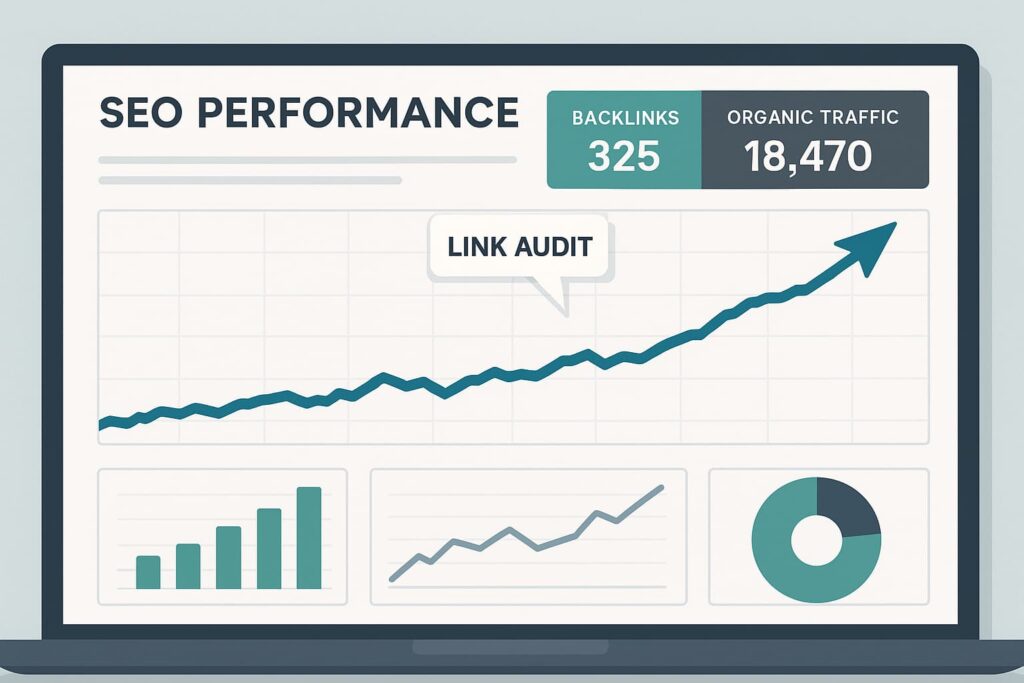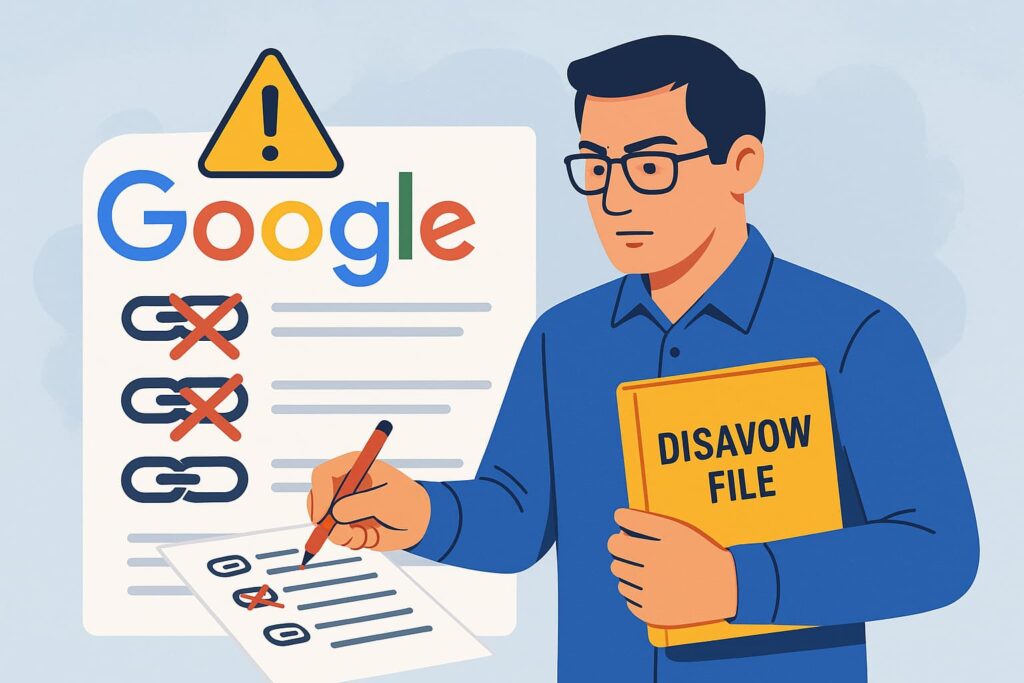A strong backlink profile is one of the most important factors for long-term SEO success. However, not all links are beneficial—some can harm your rankings if they come from low-quality or spammy sources. A professional link audit helps identify these issues and provides a clear strategy to improve your site’s authority.
A strong backlink profile is one of the most important factors for long-term SEO success. However, not all links are beneficial—some can harm your rankings if they come from low-quality or spammy sources. A professional link audit helps identify these issues and provides a clear strategy to improve your site’s authority.
Why Link Audits Matter for SEO
Google and other search engines use backlinks to assess how trustworthy and relevant your website is. While quality links from respected sources can boost your rankings, toxic or spammy links might actually hurt your visibility—or even trigger penalties.
A thorough link audit helps you:
- Remove risks – Disavow harmful backlinks early.
- Recover value – Fix broken links that still help SEO.
- Build smarter – Target strong links competitors have.
- Balance anchors – Mix branded and keyword phrases.
Without regular audits, websites risk accumulating poor-quality links that gradually weaken their SEO performance.
What a Professional Link Audit Includes
A complete link audit goes beyond just checking for toxic links. Here’s what a thorough analysis covers:
1. Backlink Scan & Inventory
A complete link audit starts by creating a full list of all your existing backlinks. Since no single tool shows the entire picture, professionals use multiple platforms such as Ahrefs, Majestic, Moz, and SEMrush. Each one collects data differently and offers unique insights. Using several tools together ensures a more accurate and thorough view of your backlink profile. This scan includes:
- All active followed and nofollow links;
- Recently lost or broken links that may be recoverable;
- Links from archived pages that might still pass value;
- Links across different TLDs and subdomains;
- Historical link acquisition patterns and velocity.
This complete inventory supports all further analysis. Advanced audits also examine link types (guest posts, directories, news mentions, etc.) to spot unnatural patterns that may trigger search engine flags. Ideally, the scan covers 2-3 years of link history.
2. Link Quality Assessment
Not all backlinks are created equally. A professional audit examines the qualitative aspects of each relationship to assess its genuine worth and possible risks. This examination helps distinguish between connections that improve your rankings and those that may really hurt your site’s performance.
Each link is evaluated based on:
- Authority – Links from high-trust domains pass more SEO value.
- Relevance – Links from related topics are more beneficial.
- Anchor Text – Too many exact matches can appear manipulative.
- Placement – In-content links are stronger than sidebar or footer ones.
The audit also examines link velocity patterns to detect sudden unnatural spikes, referring domain quality to avoid PBNs and shady sources, and link diversity to ensure a natural mix of anchor texts and link types.

3. Toxic Link Detection
Effective toxic link identification requires more than surface-level scanning — it demands a meticulous, layered evaluation process. Specialists examine backlinks through multiple filters to detect those that could damage search visibility or invite manual actions. The investigation targets connections from blacklisted link networks, compromised domains, and other questionable sources that search engines distrust.
While technology helps calculate potential threat levels, human expertise proves invaluable for context. Some technically “risky” links may be benign when examined individually, while others that appear legitimate might be part of sophisticated spam operations. The evaluation specifically looks for:
- Unnatural growth patterns (abrupt influxes of low-quality referrals)
- Over-optimized anchor text (excessive commercial keyword usage)
- Questionable source sites (adult content, gambling portals, foreign spam domains)
- Link reciprocity schemes (circular linking arrangements)
The final deliverable provides a tiered response strategy, distinguishing between:
- Links requiring direct removal requests
- Connections needing disavowal
- Borderline cases worth monitoring
This careful evaluation process helps websites keep only the valuable backlinks that actually boost their credibility, while avoiding the dangerous ones that could trigger penalties. The best audits use a smart combination of technology and human expertise to accurately tell the difference between good and bad links.
4. Lost Link Recovery
Lost link recovery is a critical component that many overlook in link audits. This process identifies previously existing high-quality backlinks that have disappeared due to website migrations, content updates, or technical errors. The audit uses historical backlink data to pinpoint these lost opportunities, then analyzes why each valuable link was lost.
For broken links, the process involves checking if the linking page still exists but the link is now pointing to a 404 error, which can often be fixed by recreating the target content or setting up proper redirects. For removed links, the audit suggests outreach strategies to webmasters, often offering updated content or other value propositions to reinstate the link. The recovery process also examines links that have changed from dofollow to nofollow status, as some of these may be worth reclaiming as followed links through relationship-building with site owners.
5. Competitive Link Gap Analysis
A competitive link gap analysis compares your backlink profile with key competitors, revealing missing linking opportunities in your strategy. Unlike basic competitor research, it pinpoints exact domains linking to competitors but not to you, highlighting clear chances for strategic link-building.
The process analyzes critical factors like competitors’ link sources—from earned media to resource pages and partnerships. It uncovers their successful tactics, such as data-driven content, influencer collaborations, and timely newsjacking tied to major events. Key metrics like anchor text diversity, domain authority distribution, and link velocity help prioritize the best opportunities.
These insights let you refine your link-building strategy, focusing on proven tactics that work for industry leaders.
6. Disavow File Creation (If Needed)
When toxic links cannot be removed through manual outreach (often because webmasters don’t respond or refuse to cooperate), creating and submitting a disavow file to Google becomes necessary. A professional audit ensures this is done precisely by:
- Prioritizing Links: Only disavowing truly harmful links that meet clear spam criteria
- Proper Formatting: Structuring the file correctly with domain-wide and URL-specific disavows
- Documenting Rationale: Maintaining records of why each link was disavowed
- Timing Strategically: Recommending when to submit based on your site’s history and recent algorithm updates
The audit should also provide guidance on monitoring the impact post-submission and when it might be safe to reconsider certain disavowed links if circumstances change. Importantly, it will warn against overuse of disavows, as removing too many links — even questionable ones — can sometimes destabilize rankings.
7. Actionable Recommendations
The report delivers a strategic link-building roadmap featuring carefully selected high-value websites with direct outreach contacts, proven content formats that perform well like research studies and interactive tools, and data-driven anchor text recommendations maintaining a natural balance of 50-60% branded terms, 30-40% natural phrases, and limited exact-match keywords.
It pinpoints technical enhancements needed for better link acquisition, reveals specific areas where competitors outperform you, and provides a structured implementation approach that progresses from immediate improvements to sustained growth initiatives — all carefully aligned with Google’s current webmaster guidelines to ensure compliance while maximizing results.
Long-Term SEO Benefits of Regular Link Audits
Regular link audits remain one of the most powerful yet frequently neglected SEO upkeep strategies. While most webmasters concentrate on gaining fresh backlinks, preserving the quality of your current link profile proves just as vital for maintaining organic rankings. Systematic professional evaluations offer continuous defense and tactical benefits that accumulate progressively.
Protects Against Ranking Losses and Penalties
Search engine algorithms change frequently, and links that were once fine could now hurt your rankings. Routine audits spot these risky links early, allowing you to remove them before they cause damage to your search performance.
Strengthens Your Site’s Authority Gradually
When you consistently remove poor-quality links and replace them with authoritative ones, search engines begin to trust your site more. This steady improvement leads to more durable rankings that don’t fluctuate wildly with every algorithm update.
Eliminates Wasted Link-Building Spending
Audits prevent you from throwing money at ineffective links. By showing exactly which links deliver value, they help you focus your budget on acquisitions that actually improve rankings.
Reveals Valuable Missed Opportunities
Frequent audits do more than just clean up – they uncover lost links worth reclaiming and show successful strategies your competitors are using. These insights often point to the easiest ways to gain quality links.
Keeps Your Link Profile Looking Natural
Search engines favor websites with organic-looking backlink profiles. Regular audits help maintain the right mix of anchor texts, relevant sources, and varied link types that algorithms interpret as natural growth.
How Often Should You Conduct a Link Audit?

The frequency of link audits should be defined by your website’s stage of development, growth speed, and amount of competition in the sector. New websites that are actively developing links should be audited every 3-6 months to discover and resolve issues early on while establishing a solid backlink profile. Established websites with steady rankings often require annual audits, although high-performing sites in competitive industries may benefit from semi-annual evaluations.
Certain situations warrant emergency audits:
- Following significant Google algorithm refreshes (core updates, spam crackdowns);
- When experiencing unexplained ranking plummets across multiple pages;
- After sudden spikes in low-quality backlinks;
- Prior to major site migrations or rebranding efforts.
For seasonal operations, pre-peak audits are mandatory, while aggressively expanding enterprises may require trimonthly assessments. The golden rule? Proactive monitoring trumps reactive damage control. Savvy SEOs blend automated monthly backlink surveillance with in-depth manual audits at these calculated junctures for maximum protection.
Preventative audits cost less than recovering from search engine penalties. As your backlink profile grows and becomes more complex, conducting audits more frequently becomes a necessary part of staying competitive.
Choosing a Reliable Link Audit Service
Free tools provide basic backlink information, but professional audits offer a more complete analysis for effective SEO. Quality services go beyond automated scans by combining data from multiple sources with expert review. This thorough process identifies issues, recovers lost links, and develops strategic approaches to improve your backlink profile.
What separates the top providers? They look at the whole picture:
- How quickly your links are growing (and whether it looks natural)
- Where your competitors are getting their best links
- Whether your anchor text looks suspicious or healthy
Most importantly, they make recommendations that actually follow Google’s current guidelines
You’re not just paying for a list of bad links—you’re getting a roadmap to build lasting search visibility. The right audit can mean the difference between constantly fixing problems and staying ahead of them.
For example, 3XE Digital delivers comprehensive link audits that merge technical backlink analysis with expert evaluation, assessing link quality, unnatural anchor text patterns, and competitive gaps while flagging toxic links for removal/disavowal, ultimately providing tailored recommendations for each site’s specific SEO needs and challenges.
Conclusion
A professional link audit is not just a one-time fix—it’s a long-term SEO strategy. By regularly reviewing your backlinks, removing harmful ones, and acquiring high-quality placements, you protect your site from penalties and improve its authority. Whether done in-house or through a trusted service, consistent audits are a key factor in sustainable search rankings.
